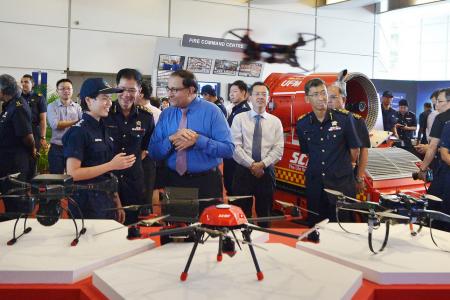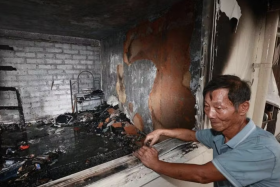SCDF to fight fires from the sky
SCDF develops the use of drones and other unmanned and electric vehicles for safer and more efficient fire-fighting
The Singapore Civil Defence Force (SCDF) will soon be fighting fires from the air.
The use of drones, or unmanned aerial vehicles (UAVs), is being developed for use in major operations.
They will complement other unmanned and electric vehicles that were unveiled yesterday to about 1,000 guests and participants at the SCDF Workplan Seminar at ITE College East.
The annual event is meant to review and reveal SCDF's plans from the past year and for the year ahead.
A chemical fire at a warehouse was used as an example of how SCDF's assets could be used to battle the blaze.
The fire is detected within seconds by the new fire and smoke tele-camera (Fast) system, which will be installed in warehouses. Conventional smoke and heat detectors require at least a few minutes to detect a fire.
The UAVs, which are equipped with cameras, swoop in to allow the SCDF to assess the fire from various angles.
Commanders then send in unmanned fire-fighting machines (UFMs), which are remotely controlled and can withstand temperatures of up to 600 deg C.
The UFMs get to the heart of the blaze to douse it with intense water mists, water jets and foam.
Then come the mobile transporters: modified Segways. Segways, which are two-wheeled electric vehicles, were chosen to do the job as they are smaller and more mobile than fire bikes.
These allow firefighters to enter affected areas quickly while detecting air toxicity levels. This information is transmitted to command vehicles nearby.
The gathering of air samples is done by systems built into the vehicle.
Lieutenant-Colonel Michael Chua, 40, the assistant director of the SCDF's Hazmat department, said getting their various assets to work together would make it more efficient to fight fires.
He said: "Mobile teams used to be just on foot, making it cumbersome. But the new equipment will enable a more effective approach, saving tens of minutes.
"And every minute, every second, is crucial in saving lives."
The equipment that SCDF will be using is based on technology that is available to the masses, like drones and the Segway.
They have been adapted and heavily modified and fitted with parts including GPRS systems and toxicity detectors.
INNOVATION
At the seminar yesterday, Second Minister for Home Affairs S. Iswaran praised the SCDF for its culture of innovation and technology development.
Commenting on its use of drones, he said: "This capability will allow SCDF to do an aerial mapping of the incident sites and have a better appreciation of the risks so as to better plan the safe and effective deployment of officers during operations."
Other equipment showcased included the augmented reality system for vehicle crash rescue training. This is a pair of goggles that allows trainees to face realistic scenarios in a virtual reality environment.
Mr Iswaran added: "SCDF must sustain operational excellence and readiness, not just to meet today's challenges but also to ensure that its operational capabilities remain effective for the future."
SCENARIO WITH SCDF’S NEW VISUAL DETECTION SYSTEM

The Fast System
Using video analytics and advanced image processing, it detects the presence of fire and smoke at its source within seconds.
It then sends an immediate alert to the fire command centre for a quick response.
It has three key components comprising CCTV, an analysis software cum recorder and a monitor screen.

The new Fire and Smoke Tele-Camera (Fast) system will be able to detect fire by sight alone.

New generation Hazmat control vehicle
The vehicle is deployed for the identification of hazardous substances, assessment of contamination and to determine the mitigation approach for the incident.
It is integrated with three key components:
- Advance detection and analytical equipment
- Command, control and communication infrastructure
- A vehicle-in-vehicle concept to incorporate Mobile Transporters

Mobile Transporter
A mobile electric vehicle to carry SCDF personnel and allows them to cover large areas quickly, while also detecting toxicity levels in the air and sending back information to the control vehicle wirelessly.
The vehicle is also equipped with sirens, blinker lights and a loudhailer system.

Unmanned Aerial Vehicle (UAV)
Small drones, fitted with cameras, allow SCDF personnel to monitor the situation of the fire from the air.
They will be deployed during large scale incidents.
These smaller UAVs, which are the size of a palm, weighs just 60g, and has a range of 100m. It can also reach a height of 10 storeys.

The drones are controlled by remote controls. They have cameras fitted that can stream live footage to the screens on the remote controls.



Drones
The SCDF is currently looking at three other models of drones to use. These drones weigh 5kg to 7kg, measure close to a metre wide, and have a range from 100m to 2km.
They also have a payload of 1kg, which will allow for thermal imaging cameras and detectors to be mounted on them.

Unmanned Firefighting Machine (UFM)
It is a remote-controlled, versatile fire-fighting unit built to operate under extreme conditions as well as complex and hazardous environment.
It can ventilate a smoke-logged area using high velocity airflow, or fight fire using intense water mist, jet or foam.
The UFM can be fitted on a new rail kit, allowing it to fight fires in MRT tunnels.
"This capability will allow SCDF to do an aerial mapping of the incident sites and have a better appreciation of the risks so as to better plan the safe and effective deployment of officers during operations."
- Mr S. Iswaran, Second Minister for Home Affairs
Help save lives
The SCDF yesterday released a mobile application called myResponder.
It can be downloaded on Android phones only, but a version for the iPhone will be released soon.
It allows the public to access information on the location of automated external defibrillators (AEDs) as well as sign up to be a community first responder.
If someone suffers a heart attack, registered users who are in the vicinity will be asked to help before SCDF personnel arrive, by taking an AED to the victim or by administering chest compressions.
So far, 100 people have volunteered to be Neighbourhood Active Responders (Near), a collaboration between the SCDF, the police and People's Association to train volunteers in life-saving and other emergency skills.
The myResponder app is part of the Save-A-Life initiative, which will see the installation of AEDs at every two HDB blocks.
It will be piloted in Bedok, Bukit Panjang, Choa Chu Kang, Pasir Ris West, Radin Mas and Tampines West.
Get The New Paper on your phone with the free TNP app. Download from the Apple App Store or Google Play Store now



